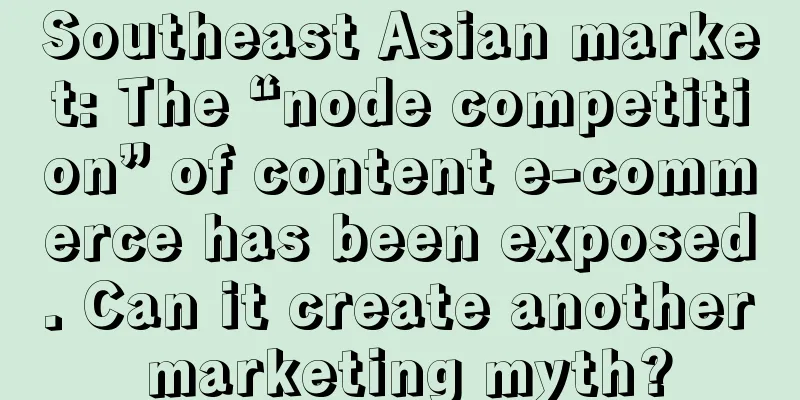Southeast Asian market: The “node competition” of content e-commerce has been exposed. Can it create another marketing myth?

|
Southeast Asia, a fertile land for overseas expansion that is full of infinite possibilities, is attracting many consumer brands to join in and compete for supremacy. For merchants, leveraging local festivals and major events to conduct brand marketing is an excellent opportunity that cannot be missed for brand expansion. From traditional festivals to international shopping festivals, many consumer brands have taken advantage of major promotional events to occupy the market and thrive. For Southeast Asian Muslims, the Ramadan that just passed is equivalent to the "Spring Festival", which is the most important festival of the year, and pre-holiday shopping is essential. Around Eid, TikTok in Southeast Asian countries was filled with short videos preparing for and celebrating Eid, and popular content included family gatherings and prayers. For consumers and tourists in countries such as Thailand and Laos, Songkran Festival is also the most lively and festive time of the year. Around April 13-15, many Songkran Festival topics and challenges appeared on TikTok, including Thai-style makeup, as well as joyful scenes of water gun battles and bucket battles on the streets of Songkran Festival, which attracted a surge in traffic. Cross-border e-commerce sellers in Southeast Asia have just survived the two "stressful" promotion nodes in the first half of the year. In the second half of the year, the "9.9", "10.10", "11.11", "12.12" and "Double Day" Mega sales are coming one after another, and the next round of "node competition" is about to begin. Given the importance of "festival marketing" in the Southeast Asian market, how to "win" the important festival node marketing competition in the Southeast Asian market has become the most concerned issue for merchants. Image source: TikTok @aydagifts_ 0 1 Southeast Asian people Caught in the battle of "local festival marketing" During holidays in Southeast Asian countries, local residents have strong purchasing power, which makes it the most attractive time to bring goods. When cross-border e-commerce sellers enter the Southeast Asian market and formulate market strategies, they must first have a deep understanding of and respect the unique culture, language, religious beliefs and festival traditions of each country, and they must also consider the diversity and complexity of the Southeast Asian market. In the exploration of cross-border e-commerce localization, the numerous holidays in the Southeast Asian market and the cultural differences between different countries have made many sellers feel a strong cultural barrier: Indonesia, the largest economy in Southeast Asia, has annual festivals including Eid al-Fitr, Eid al-Adha, National Awakening Day, Independence Day and other local festivals; while in Singapore, where the Chinese population accounts for more than 74%, people attach great importance to both the Chinese New Year and Christmas under the influence of Western culture. Vietnam, on the other hand, has integrated Chinese culture, Indian culture and Western culture to form a unique cultural system. The main festivals for local people are Vietnam's National Day, South Vietnam Liberation Day, and Ho Chi Minh's birthday, etc. Image source: TikTok for Business "2024 Global Consumer Trends White Paper - Southeast Asia" Secondly, accurately grasping the marketing rhythm of holiday nodes is a key link in Southeast Asia’s “local holiday marketing”. For example, in the just-concluded Ramadan marketing, although many domestic sellers have tried to understand the "Ramadan" culture of the local market, many people still have a superficial understanding of localized holiday promotions. "In fact, Ramadan is the New Year for Indonesians. People usually buy things before the New Year and come back to work after the New Year." A Southeast Asian e-commerce seller told Xiaguangshe. According to the experience of cross-border e-commerce sellers, "the real sales and traffic are good during the marketing period before Ramadan. We have to stock more goods in local warehouses because we sell more." During the local holidays from April 10 to 18, traffic will enter a period of flatness. For Indonesian residents, the "return home (Mudik)" after Eid al-Fitr is the most crowded and congested time of the year. People will spend more time visiting relatives and friends and having family gatherings to spend this leisure time. During this period, everyone has just passed the peak consumption season, and the promotional activities of major online and offline supermarkets and e-commerce companies have also come to an end. Therefore, accurately grasping the marketing rhythm is crucial to the success or failure of merchants' marketing activities. If you "enter the market" too late, you will miss the almost annual holiday marketing opportunity. At the same time, successful cross-border e-commerce sellers in Southeast Asia are relatively good at understanding the local business environment, understanding local policy orientations, studying local user consumption behaviors, and developing personalized marketing activities. Merchants can combine social media platforms such as TikTok to more effectively reach and attract potential young consumers. For example, according to the local labor law in Indonesia, companies need to pay Muslim employees 1-2 weeks before Eid al-Fitr so that they can spend money on the holiday. This group of young people working in big cities are more likely to spend on emerging products and consumer goods, and they are the target customers and potential consumers of cross-border merchants in the local market. Southeast Asian cross-border e-commerce sellers are using more popular social media platforms to conduct targeted promotions for this group of people with spending power. TikTok, in particular, has a large number of young users, which is particularly important for businesses to target the young market. TikTok encourages users to create and share creative content, including dances, challenges, special effects, and funny videos. Merchants' content can easily spread, and a successful short video can quickly attract millions of views, bringing huge exposure and conversions to the brand. 0 2 Tik Tok is full of festive atmosphere Users pay for “great value for money” TikTok has become almost the most important content platform in Southeast Asia's "local festival marketing". Merchants can work with influencers and users to create diverse, interesting and exciting short video content, and can also provide users with immersive experience and interactive gameplay through live broadcasts, so that products can be presented most intuitively and clearly, directly hitting consumers' needs and minds. According to the data from TikTok for Business's "2024 Global Consumer Trends White Paper - Southeast Asia", 48% of Southeast Asian consumers watch TikTok's online live streaming at least once a week. Among them, viewers in Vietnam, Thailand, and Malaysia watch TikTok's live streaming more frequently. An investor focusing on the Southeast Asian Indonesian market told us: Locals are increasingly accustomed to spending their leisure time with TikTok, and are also unknowingly exposed to new brands and products. Especially during festivals, many users will share local cultural content such as food and drinks on TikTok, and the number of video views and creations has increased significantly. The content posted on TikTok can also be quickly spread through users' sharing and imitation. During Ramadan, some food bloggers on TikTok will post ideas and recipes for Iftar during Ramadan (including some trendy healthy light meals such as fresh fruits, yogurt, nuts and dried fruits), attracting countless followers to imitate. The preferential promotional information of food, tableware, gifts, etc. mentioned in the video has also become a shopping inspiration for consumption. For example, some Ramadan entertainment content on TikTok carries the hashtags #BeautyTok or #eidmakeup (Eid makeup). Beauty bloggers focus on showing lipsticks and mascaras suitable for Eid. The cumulative number of views of the topic #eidmakeup (Eid makeup) alone during Ramadan reached 180 million. Similarly, during the just-concluded Songkran Festival in Thailand, short videos about Songkran toys, clothing, and even sunglasses appeared in an endless stream in the short videos of Thai TikTok influencers. Many young Thai people are influenced by the trends on social media such as TikTok and choose Songkran toys and equipment as well as sun protection products, such as Crocs, sunscreen, and raincoats that can be worn during the Songkran Festival. Image source: Unsplash MeToo, an oral fast-moving consumer goods brand, observed the rigid demand for mouthwash during the Ramadan period in Indonesia, so it chose to promote its new product on TikTok, targeting young consumers and fashion brands with its mouthwash as a breakthrough point, and adopted a "three-step" marketing strategy: The first step is to gather creative ideas. MeToo integrates product ingredients and functions into interactive creativity. When users touch the mouthwash in the video, they can trigger the special effect of teeth whitening, which not only increases the fun but also allows users to effectively understand the value of the product. The second step is to expand the number of influencers. MeToo invites local celebrities and top influencers to participate in the challenge, which helps the challenge to gain further spread and exposure, and makes MeToo quickly recognized. The third step is long-term operation. MeToo fully utilized the native traffic brought by the challenge and combined it with the commercial traffic brought by brand advertising and bidding advertising to jointly promote new products. In addition, it seized the popularity of the Ramadan Challenge and continued to invest in the next few months to drive product sales. MeToo's "three-step" strategy of launching new products through the TikTok community to accurately find consumers, collaborating with local influencers on TikTok to enter the circle's field of vision, and using the Ramadan holiday promotion to break the circle of new products has helped it to quickly expand its territory in the Southeast Asian market. One week after the product was launched, it reached the top 3 of the TikTok Shop fast-moving consumer goods rankings. Image source: Screenshot of MeToo@TikTok short video In terms of consumer mentality, Southeast Asian consumers do attach great importance to preferential prices, but not "low prices only" as many sellers speculate. According to TikTok for Business's "2024 Global Consumer Trends White Paper - Southeast Asia", Southeast Asian consumers are pursuing a balance between quality and price, and they need to feel that they have "gotten a good deal". Based on this mentality of "pursuing cost-effectiveness", Southeast Asian consumers are more reluctant to miss any node marketing and promotional activities. Petsup, a pet food overseas brand, once mentioned in an interview, "Consumers in Southeast Asia have a very mature understanding of big sales. We will cooperate with the big sales cycle to carry out targeted promotions and increase advertising investment." The competition in the pet food and care products market in Southeast Asia is relatively fierce. Local consumers have a higher demand for high-quality, natural, organic and additive-free pet food. Discounts and low-price purchases under appropriate promotional activities can better impress consumers. Many businesses choose to amplify the sense of product value through TikTok live streaming during holiday promotions: live streaming can make consumers better perceive the value of goods through the host’s explanation and real-time display; at the same time, the live broadcast room’s "limited time offers" and "on-site calculated discounts" and other gameplay meet consumers' pursuit of cost-effectiveness, making consumers feel that they have seized a rare opportunity to obtain product information. As a result, merchants can provide consumers with a profound and thorough "profitable" shopping experience through TikTok's social attributes and resource products, which also enhances user engagement and improves brand loyalty. Image source: TikTok for Business "2024 Global Consumer Trends White Paper - Southeast Asia" 0 3 The big move to boost node sales: Sellers use Tik Tok to run the entire chain If merchants and brands can efficiently link all channels during big promotions, they will have a better chance of boosting sales. TikTok for Business's content creativity and traffic guidance strategies can undoubtedly help merchants smoothly connect to multiple sales channels such as online and offline, direct distribution, etc., which can be said to kill two birds with one stone and get twice the result with half the effort. Specifically, as a social platform and content e-commerce, TikTok can attract users to place orders directly on TikTok Shop through creative short videos and live broadcast content. This closed-loop ecosystem provides merchants with a direct sales platform for TikTok Shop. Many consumers begin to have an impression of a brand or a new creative product when watching short videos on a daily basis. Once they are interested or have a favorable impression, consumers can directly jump to the in-site purchase scene such as TikTok Shop through short videos. For example, POSEE, a brand that sells slippers, entered TikTok Shop in June 2022. Through short videos, it opened up markets in the Philippines, Vietnam, and Thailand, with hundreds of orders in each market every day. In October 2022, POSEE also entered the live streaming sales track. After 8 months of development, POSEE's overseas GMV has increased by 300%, becoming the top seller in the cross-border fashion industry on TikTok Shop. Image source: Screenshot of POSEE TikTok account TikTok can also direct user traffic to the merchant's own independent website or other direct sales channels. Content e-commerce can bring immeasurable exposure to brands with rich, interesting and fascinating content creativity. Many Southeast Asian brands create short video content to showcase product features and usage scenarios, and directly attach links to independent websites in video descriptions to guide users to visit and purchase. For example, a handmade jewelry brand gained a lot of attention on TikTok by posting videos showing the production process and finished products, and successfully converted traffic into orders for its independent website. An emerging women's fashion store also launched a topic challenge on TikTok to warm up for the shopping festival and attract consumers to visit the platform and offline stores to buy products during the promotion period. In addition, TikTok's online marketing also brings direct traffic to the brand's offline stores. According to the survey data of TikTok for Business's "2024 Global Consumer Trends White Paper - Southeast Asia", a large number of Southeast Asian consumers are more likely to be motivated to experience products after browsing social media, and to actually evaluate product quality offline or experience corresponding products/services. These behaviors can not only deepen consumers' brand impressions, but also push consumers' purchasing behavior one step further. Makuku, an overseas maternal and infant brand, said in an interview, "The traffic on TikTok not only overflows online, but also greatly overflows to our offline sales channels. Previous research shows that nearly 20% of consumers went to our stores after learning about our brand through TikTok." The dual online and offline channels allow products to reach the target consumer group clearly and intuitively. Dreame, a Chinese cleaning appliance brand, also uses TikTok to attract offline store traffic in its layout and development in the Southeast Asian market. Dreame began to deploy TikTok in Southeast Asia in 2022. It not only made strong efforts online, but also used online traffic to penetrate the local offline market, integrating online and offline to create innovative retail scenarios for consumer brands. In August 2022, during the launch of its new product in the Vietnamese market, Dreame invited TikTok's top Vietnamese influencers to participate in the offline press conference and live broadcast online simultaneously; in early 2024, Dreame signed a brand spokesperson "Xiao Shui" Baifern Pimchanok in Southeast Asia to increase brand exposure through endorsement publicity, and combined TikTok Super Product Day activities and influencer live broadcasts to drive product sales. Taking the Vietnamese market as an example, Dreame achieved a single-day maximum GMV of more than US$100,000. Image source: Dreame In addition to empowering merchants and brands' direct sales channels, merchants can also use TikTok to more conveniently and effectively layout distribution channels. For brands that have settled in offline channels such as convenience stores and supermarkets, on the one hand, they need consumer traffic and attention, and on the other hand, they also need the cooperation of dealers to achieve strong sales performance in offline channels. Brands promote products on TikTok and mention offline channels through cooperation with influencers and short video ads, so that consumers can better understand the products and form a certain brand mindset; under this premise, when consumers walk into offline stores, they will be more likely to experience the products and place orders to buy them. At the same time, dealers will decide whether to purchase products based on the popularity of the products online. When a product becomes popular on TikTok, dealers will choose to purchase more products, which is also conducive to consumers' long-term shopping choices offline. Bioaqua, a beauty and personal care brand, is a typical example of successfully using TikTok to build up its voice and thus help penetrate the distribution network. Bioaqua has nearly 1.8 million followers on TikTok, and the high-frequency traffic exposure has brought it more than 30 million US dollars in sales; relying on TikTok's initial success, Bioaqua invested in offline channels in 2022, and has now settled in offline stores such as MINISO, Dandan, and Indomaret, and has established dozens of franchise stores in Jakarta, and has also created pop-up stores and brand-integrated Internet celebrity stores. Bioaqua has initially captured the minds of consumers through TikTok, and then leveraged its popularity to further expand offline channels. It can be said that it has mastered both online e-commerce and offline distribution networks, attacking on two fronts and making a strong foray into Indonesia. 0 4 Five steps to win the Southeast Asia node competition In the coming May and June, Southeast Asia will usher in the Summer Lent Festival and the summer vacation economy with a large number of tourists ; in addition, Southeast Asia’s “66 Big Sale” is also a time node that overseas merchants cannot miss. Based on the experience of the previous "66 Big Promotion", merchants can take advantage of the TikTok platform to launch intensive promotional activities, including direct price reductions of goods in the live broadcast room, platform discounts, joint venture coupons and other strategies. In addition, summer beauty and personal care, women's underwear, 3C digital products that are more suitable for May and June, and Muslim fashion categories that are particularly popular on the Malaysian site will be the focus of merchants to strengthen their brand image and promote sales in the future. As the bubble of consumer brands gradually disappears, brands are entering the deep waters of Southeast Asia, and the importance of fine operations is becoming more and more prominent. The so-called "festival hits" and "node marketing" are a deep localization strategy for brands in the Southeast Asian market that adapts to local conditions and the times. In summary, taking these 5 steps well will give you a better chance of winning the node marketing in Southeast Asia: 1. Deeply understand and respect the unique culture and festival traditions of each country and develop effective localized marketing strategies 2. Accurately grasp the festival nodes and launch promotional activities 3. Make good use of social media platforms such as TikTok to attract young consumers’ attention and participation 4. Grasp the psychology of local consumers seeking cost-effectiveness and affordability, and use TikTok to amplify the value of products 5. Use TikTok to expand your omnichannel sales Of course, when a brand goes overseas, in addition to node marketing, there is a series of important tasks worth doing. Now the countdown to the opening of TK's practical running-up camp in the US is on, and friends who are interested can take a look. |
<<: Beware! These Google Ads Misconceptions May Affect Your Cross-Border E-Commerce Business
Recommend
What is empisports? empisports review
empisports is an exciting contemporary brand focus...
Some sellers have received emails stating that some Amazon sites will charge additional advertising management fees starting from August 15?
Anonymous user My C position 1. Some sites will ch...
What is Promotion? Promotion Review
Promotion is an activity launched by Amazon to enc...
What is Kinnek? Kinnek Review
Founded in 2012, Kinnek is a technology platform t...
What is the demand for online fashion shopping in the United States? What are the characteristics of consumer behavior?
It is learned that DigitalCommerce360 and BizrateI...
What is IP Accelerator? IP Accelerator Review
IP Accelerator is a program designed to enable bra...
What is New Retail? New Retail Review
New retail refers to a new retail model that relie...
"US Beauty Market Report": These sub-categories will be the best-selling in 2022!
It is learned that according to data from market r...
Concealment leads to disaster again! Just now, a COSCO SHIPPING cargo ship was in trouble!!!
Logistics is no small matter, but many people tak...
What is Listing Eagle? Listing Eagle Review
Listing Eagle is a tool that monitors sellers’ lis...
How to appeal against abuse of Amazon brand registration?
2 Common Types of Brand Abuse 1. When applying fo...
Mom: "Why are you still doing cross-border e-commerce? Go home and take the civil service exam."
Scan the QR code to join our seller family More i...
An article to understand the necessary path for Amazon sellers to operate
Traffic--Conversion Rate--Ranking At present, the...
U.S. online grocery sales surge 88%
It is learned that recently, according to data fro...
Amazon is testing a new feature! Sellers have another traffic entrance
Some time ago, Amazon carried out a large-scale r...









